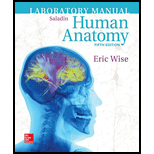
Concept explainers
To determine:
The scope of histology and its relation with cytology and gross anatomy.
Introduction:
The study of tissues and their arrangement into organs is called histology. The study of cellular structure and function at the scientific level is termed as cytology. The macroscopic study of anatomy is known as gross anatomy.
Explanation of Solution
Histology uses modern imaging techniques to examine and describe the tissues and structures present. It helps in understanding the function of most organisms. It is used in various professional fields such as lab analysis, research, and medical professionals. It is also used in
Histology involves examining process at the tissue level, and cytology involves examining at the cellular level. These both techniques are performed at the microscopic level. Histology is the study of anatomy at the microscopic level, whereas gross anatomy is the study of anatomy at the macroscopic level. All these techniques are used to describe the structure and functioning of the body parts.
Thus, the scope of histology is in various professional fields such as lab analysis, research, and medical professional. Histology, cytology, and gross anatomy are used to describe the structure of the body parts.
Want to see more full solutions like this?
Chapter 3 Solutions
Laboratory Manual for Human Anatomy
- The distinctions between epithelial tissues and connective tissues.arrow_forwardWhy the terms ventral and dorsal are ambiguous in human anatomy but less so in most other animals; what terms are used in their place in human anatomy; and reasons why they are occasionally appropriate or unavoidable in human anatomyarrow_forwardState a meaning of each word element, and give a medical term that uses it or a slight variation of it.5. palp-arrow_forward
- The inner lining of the vessel (intimate) from the inside extends the epithelium. Name it. Mesothelium. multilayered epithelium Epidermis. Transitional epithelium. O Endotheliumarrow_forwardOrgans of the abdominal cavity are held in place by connective tissue sheets called ___________.arrow_forwardThe five external factors to be present or provided to sustain life.arrow_forward
- Understanding Health Insurance: A Guide to Billin...Health & NutritionISBN:9781337679480Author:GREENPublisher:Cengage
 Medical Terminology for Health Professions, Spira...Health & NutritionISBN:9781305634350Author:Ann Ehrlich, Carol L. Schroeder, Laura Ehrlich, Katrina A. SchroederPublisher:Cengage Learning
Medical Terminology for Health Professions, Spira...Health & NutritionISBN:9781305634350Author:Ann Ehrlich, Carol L. Schroeder, Laura Ehrlich, Katrina A. SchroederPublisher:Cengage Learning  Cardiopulmonary Anatomy & PhysiologyBiologyISBN:9781337794909Author:Des Jardins, Terry.Publisher:Cengage Learning,Essentials Health Info Management Principles/Prac...Health & NutritionISBN:9780357191651Author:BowiePublisher:Cengage
Cardiopulmonary Anatomy & PhysiologyBiologyISBN:9781337794909Author:Des Jardins, Terry.Publisher:Cengage Learning,Essentials Health Info Management Principles/Prac...Health & NutritionISBN:9780357191651Author:BowiePublisher:Cengage





